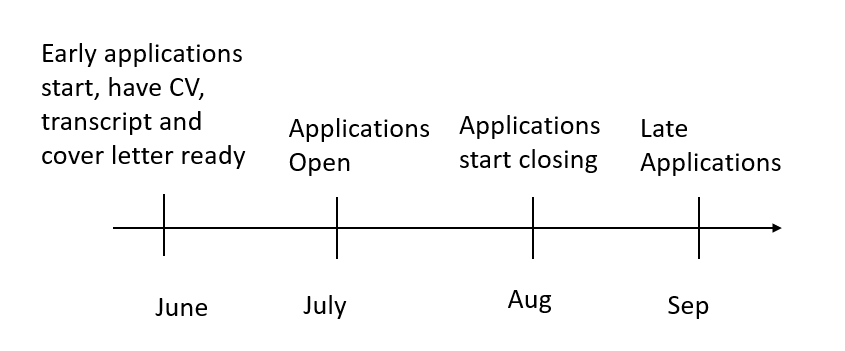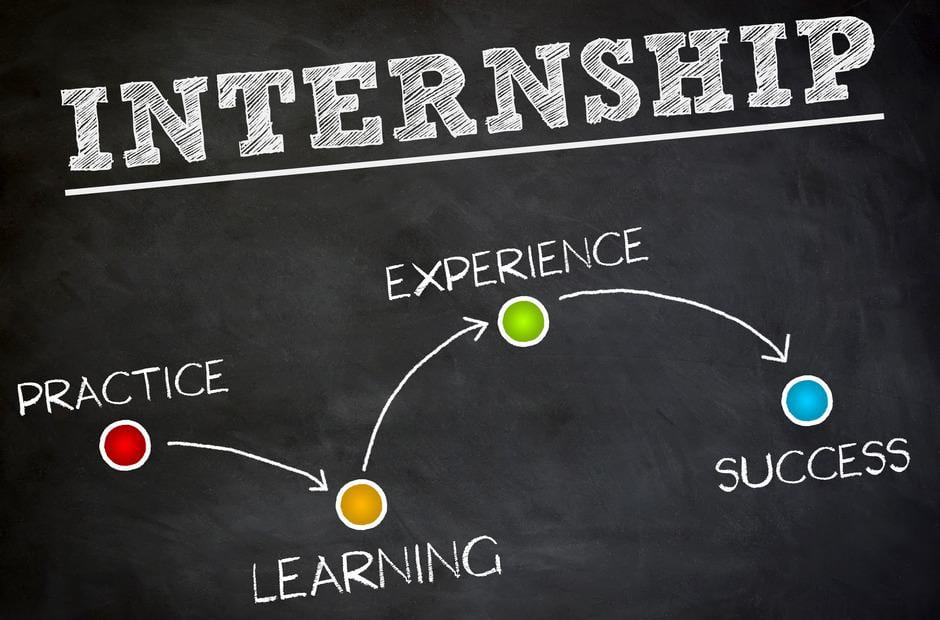Introduction
Internships!
What a word that makes us tremble!
Unfortunately, all engineering students must complete 800 hours of internship to graduate.
(for more information -> https://www.auckland.ac.nz/en/engineering/current-students/undergraduate/practical-work.html)
Although there is a lot of helps here and there, I got together a guide in finding an internship.
A bit of a disclaimer; this was how I got my internship, and there are many different ways in securing an internship so please use this just for reference!
1. Write a CV
The very first step of getting an internship is to write a CV.
What is a CV? It is a document around 2 pages summarising your work experiences, skills, and extracurricular activities. Basically a document showing off “Look, I did this!”
I know it’s extremely difficult to motivate yourself to do something without a due date, like writing a CV, so I’m giving a brief timeline.
Most internships generally open in July, closing in August, however, some of the early ones start in June, so I’d say the end of 1st sem is a good time to have a finished CV ready.
In my case, I had a CV I wrote in high school by downloading the template from Career NZ, and I edited this version to add more work experience and extracurricular activities. I also got the CV checked by CDES (both online and in person) and edited the CV based on those feedback. I’d recommend going to CDES, or if you have a part 3 or 4, you know, go and ask them to check it for you!
There is no answer to how to write a CV, but it should generally be less than 2 pages, have no grammar errors (use Grammarly), and be neat.
2. Write a Cover Letter
While writing a cover letter seemed excessive, quite a few companies want extra information from you!
For the cover letter formatting, I had 4 sections:
A) a short paragraph about the company and what drew me to them. E.g., I was intrigued by your care in sustainability, showed by ABC event; I attended XX event and was excited to learn more about YY.
B) school work- I generally wrote about the skills I learned in university, like Matlab, inventor, C, and R.
C) Work experience and what skills I have obtained e.g. customer service, teamwork, communication
D) extracurricular
For example, I am doing MECHA (Student Association for Mechanical and Mechatronics Students) and an excellent place to get inspiration for writing this is LinkedIn or your club website.
I didn’t change sections B, C and D for different companies, but section A was dependent on the company I was applying for.
Make sure to change the company name you are applying for! (Don’t make the mistake I did!)
There are a lot of examples online to refer to, so do use your research!
3. Get a transcript
Quite commonly, the company might ask you for your academic transcript. There are two types of transcript you can get:
A. Unofficial. This is free but has a huge unofficial watermark, which means you could potentially look less professional
B. Official. This costs $30
How to get your transcript? Well follow this link:
Log into your sso, select this and follow the instructions.

Companies will start advertising their internships in July, so it might be a good idea to get a transcript from semester 1 (only containing your grades from Part 1) and then get another one after the exam grades for sem 1 part 2 have been released. Note you have to pay every single time you request for a new transcript.
4. Actually apply!!!!
This part could be scary. I had many concerns; for example, what if the company doesn’t hire 2nd years? What if they don’t like my application? Would I be a laughing stock?
In short terms, just apply!
Yes, you might have a low chance of getting the job, but 0.000001% is better than 0%, which is the probability of getting the job if you don’t apply.
I applied for 16 companies before I got an offer, so don’t be too disheartened about being rejected! (Or being ghosted!)
I recommend having a spreadsheet showing the due dates a short description of what the company does, and the link to the application form. This reduces the stress of searching up everything!
(below is the headline for the spreadsheet I was using)

I also had job alerts from Jora, Seek, SJS, LinkedIn and Indeed from the start of the year (probably was not necessary from the start of the year, but May might be a good time to turn these on), which piled application adverts into my emails.
Some companies have extra questions aside from the CV and cover letter, so consider the questions before submitting your application!
Also don’t apply on the due date. Sometimes, the role is already filled in by the deadline, and the job will no longer be available.
When I first started applying, I was up at 1am writing like a zombie because I had absolutely no motivation (surprisingly did get one offer from late-night zombie applications), but try to squeeze in a time during your free time to do the applications when you have a better sense of mind. Semester break (between sem 1 and sem 2) is an excellent time to get all your documents together and start your application process.
So here’s the timeline I would recommend:

Be prepared to apply for at least 20 places if you want to get an internship within your 2nd year.
5. LinkedIn.
LinkedIn. It’s like Instagram but for corporate people.
Why do we need it?
Some companies advertise their jobs through LinkedIn, and getting information about what they do is easier.
These are the steps in setting up your LinkedIn.
a) Get a photo of yourself. Generally, people use photos from formal events, such as ball, but having a nice photo outdoors will also work.
b) Set up your bio and work experiences. Take inspiration from your peers!
And done! All good to go!
6. Career expos
You may have noticed some of the emails you’ve been getting include advertisements about the career expos.
But what is a career expo?
Basically it’s an event when a bunch of companies (by bunch, I mean like 100 companies) all set up a booth in the engineering building (or whatever venue) and advertise their job opportunities. Students can go there and talk to current employees, connect with them, and learn more about the company.
When writing my cover letter, I sometimes used the points I discussed in these meetings.
E.g. I heard about xx project in the May career expo…
Although there are few career expos throughout the year, I recommend going to the ones in the first semester, as there are generally fewer people and you can have a chance to talk to the employees. Also you get a lot of free stuff! (Engineering gives you a lot of free stuff!)
There is also an opportunity for you to get your CV checked during the expo, and it is also a chance for you to network (hint, hint, LinkedIn), so if you’re not too busy, it might be worth missing a lecture or two. Lectures you can rewatch, but the expo doesn’t come every day.
For these expos, they do generally promote civil/structural or software roles, but don’t fear future Mechanical engineers! Try to search for the companies before you attend, and go to the booth, and introduce yourself as a mechanical engineering student. If they are not actively looking for a mechanical engineering student, they will give you an awkward smile, but civil companies usually do hire some mechanical engineering students!
7. Mechanical Engineering Role
I haven’t started my internship role yet, but the roles I did apply for as a Mechanical Engineer were:
- Building Services
- Mining
- Hydraulics
- Public Transport
- Fire Engineering
- Project Management.
- Gas Delivery
- ….And more!
Mechanical Engineering does open up a large variety of roles in the industry (basically anything that moves and energy!) so be excited about the future!
8. Other general tips
Start early!
I admit I went a little overboard in that aspect; I was stressing about it during part 1, searching for jobs and asking everyone how to get an internship.
“Early,” I’d say, writing your CV in May (although there are opportunities earlier), getting them checked and ready to go.
Job alerts are helpful, but don’t have so many you constantly get stressed by the enormous amount of emails. Making a spreadsheet with all the different application page links can reduce time spent frantically searching through piles of emails.
If you get an interview, watch some “How do answer interview question” videos on youtube before going, research the company (e.g. look at their project section or blog to see their latest interests) to show you are actually interested in the company. (You can’t just say oh, I need the job because I want to graduate!)
There are opportunities by the engineering clubs like speed interviews, internship insights and other networking events that would be useful to attend, so keep an eye out for those advertisements done by the clubs! (Check your discord, Instagram or facebook about these events)
ONE LAST NOTE:
It’s not the end of the world if you don’t get an internship!
It is more difficult for a second year to get an internship as companies generally prefer third years (note, some companies hire a lot of second years, too), and it is perfectly fine to choose not to have an internship during the summer.
That’s all from me today, good luck with all your course work and see you in two week!
